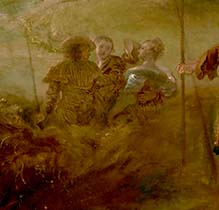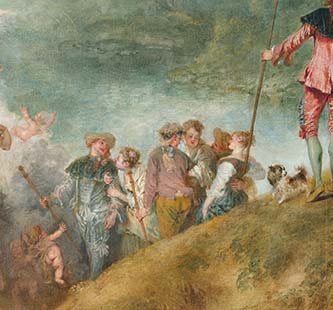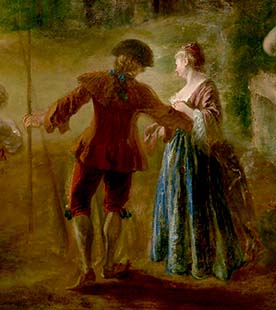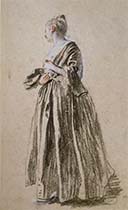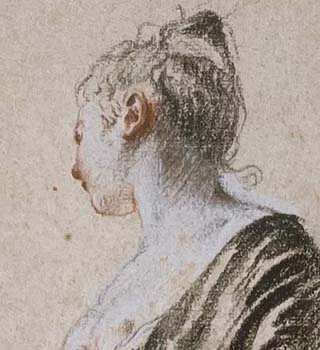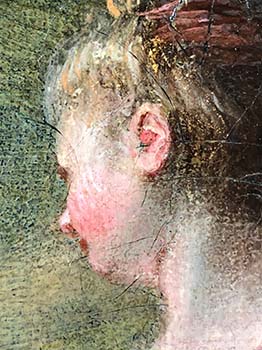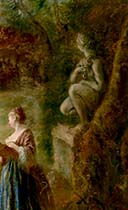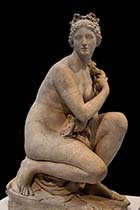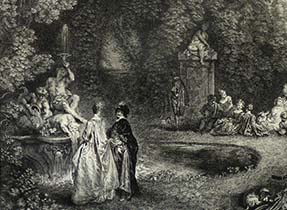
- Home Page
- Accepted
Paintings & Copies - Doubtful
Attributions - Doubtful Textual References
- Alternative
Titles - Collectors &
Museums - Bibliography
- Search Abecedario
- Watteau &
His Circle
X. Le Départ des pèlerins pour l’isle de Cythère
Entered May 2021; revised October 2021
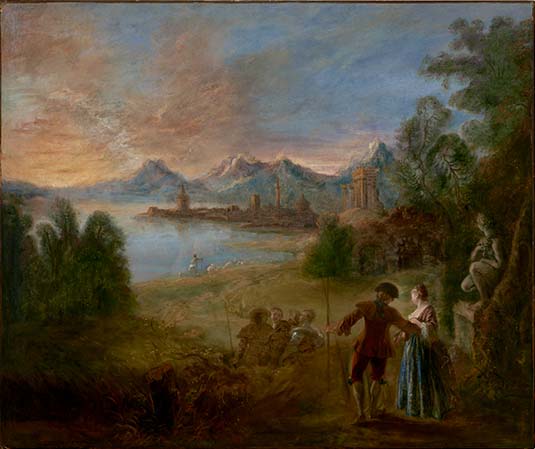
New York and Paris art market, 2020-21
Oil on canvas
97 x 116 cm
ALTERNATIVE TITLES
Le Départ pour Cythère
Embarkation for the Island of Love
La Promenade elegante
Voyage à Cythère
PROVENANCE
Paris, sale, May 13, 1765, lot 177: “Un Tableau représentant le départ des Pèlerins pour l’Isle de Cyterre, peint par Vateau, sur toile, de 3 pieds de haut, sur 4 pieds de large, avec bordure dorée.” The annotated copy of the sale catalogue in the Bibliothèque nationale has prices next to many lots but not next to this entry, suggesting that this picture did not sell. This is borne out by another sale of the picture later that same year.
Paris, sale, December 2, 1765, lot 247: “Un Tableau représentant le départ des Pèlerins pour l’Isle de Cythère, peint par Watteau, sur toile, de 4 pieds de large, sur 3 pieds de haut, dans sa bordure dorée.”
Paris, collection of Antoine Joseph d’Eslacs, marquis de Arcambal (1727-1789; military officer). His sale, Paris, February 22, 1776, lot 83: “Antoine Vatteau. Un Paysage chaud de couleur, & saisi à l’effet du Soleil couchant: sur un terrain élevé se voient les ruines d’un Temple, & plus loin, dans le fond, un Village entouré de montagnes, & bordé d’une riviere; & sur le devant, quelques Figures de Pelerins se tenant sous les bras, & prêts à passer un chemin de roches: hauteur trente-six pouces, largeur quarante-huit. T.” Sold for 364 livres according to an annotated copy of the catalogue in the Bibliothèque nationale, Paris.
Paris, collection of Charles Goury, marquis de Champgrand (1732-1799). His sale, Paris, March 20-24, 1787, lot 203: “PAR LE MÊME [A. WATTEAU]. Un grand paysage de site champêtre terminé dans le fonds par une vue de riviere; sur le devant sont différent personnagess sous des costumes de pellerins; le ton de l’ensemble en est chaude, & annonce une soirée d’été. Hauteur 36 pouces, largeur 42 pouces. T.” Sold for 60.5 livres, according to an annotated copy of the sale catalogue in the Bibliothèque nationale.
Paris, with Ernest Gimpel (1858-1907) and his wife Adelle Vuitton (1862-1915); she sold it in 1907 to Ernest Cronier
Paris, collection of Ernest Cronier (1840–1905; sugar magnate). Paris. His sale, Galerie Georges Petit, December 4-5, 1905, lot 5: “ECOLE FRANÇAISE . . . La Promenade galante. Dans le soir qui descend, des personnages en costume de mezzetins, et des femmes en bergères Louis XV, achèvent une journée de Plaisir passé dans un paysage d’imaginaire enchantement. Cadre en bois sculpté, époque Louis XV. Toile. Haut., 98 cent; larg., 1 m. 16.” Bought by François Kleinberger (c. 1858-1936; art dealer) in partnership with Edouard Warneck (1834-1924; art dealer).
Sold to Georges Wildenstein on December 3, 1921, according to the Kleinberger Gallery records, inv. 7115, now held by the Metropolitan Museum of Art.
Paris with George Wildenstein (1892-1963; art dealer). Seized by the Germans, with custody transferred to Einsatzstab Reichsleiter Rosenberg at the Jeu de paume, ERR no W126, October 30, 1940.
Recovered by The Monuments, Fine Art, and Archive Section of the Allied Forces, at the salt mines in Alt Ausee, Austria, no. 220/6.
Munich, Allied Central Collecting Point, no. 220/6, on June 20, 1945.
Repatriated to France on July 31, 1946, and restituted to Wildenstein.
Paris, Galerie Voltaire (advertised for sale in Apollo, 97 (January 1973), 62).
Paris, with J. L. Souffrice (art dealer).
Paris, sale, Hôtel Drouot (Fraysse & Associés), June 6, 2018, lot 243: “Ecole Française du XVIIIe siècle, entourage d’Antoine WATTEAU / Pèlerins dans un paysage agreste / Toile. 85 x 115 cm / Restaurations anciennes. Au dos une étiquette du Baltimore Museum of Art. Cadre en bois sculpté et doré d’époque Louis XIV. 4 000 / 6 000 €” Sold for €4,200.
London, art market; consigned to Christie’s, New York.
EXHIBITIONS
Baltimore, Baltimore Museum of Art, French Art of the XVIII Century (1924), cat. 22 (by Watteau, Embarkation for the Island of Love, lent by Wildenstein).
SELECT BIBLIOGRAPHY
Dacier, Vuaflart, and Hérold, Jean de Jullienne et les graveurs (1921-29), 3: under cat. 110.
Washington, Paris, Berlin, Watteau 1684-1721 (1984), under cat. 61
REMARKS
Tracing the provenance of this painting is difficult because of the picture’s similarity to the Louvre Pèlerinage à l’isle de Cythère. Thus reference to this painting may be hidden among the many references to copies after Watteau’s famous painting. Nonetheless, because this painting was frequently referred to as Le Départ des pélerins pour l’isle de Cythère or a variant thereof, some of the painting’s many changes of ownership can be followed, and allow us to trace the picture back as far as the second half of the eighteenth century.
The whereabouts of the painting in the early eighteenth and the nineteenth centuries are unclear. There are numerous references to paintings with the theme of pilgrims to Cythera, but generally without dimensions or full descriptions, so that no definitive provenance can be established. Among the potential references are the following:
Paris, collection of Joseph Gabriel Agard (1696-1750; art dealer). Cited in the inventory of his collection: “Item un grand Vateau représentant les Pélerins de Cithère dans sa bordure de bois sculpté dont prisé trente-six livres.” See Gady and Glorieux, “Agard,” 104.
Paris, Hôtel Bullion, anonymous sale, March 28, 1831, lot 94: “WATEAU. Esquisse connu sous le titre du Voyage à Cythère. Cette production est considéré comme la première pensée de ce maître.” This could also be a painting that was painted freely, in a sketchy manner. Or it could be a partial repetition of the composition, such as Bon voyage.
Paris, Leullier collection. His sale, January 20-21 1834, lot 111: WATTEAU (Antoine) . . . Le Départ pour Cythère; esquisse.”
Paris (?), collection of M.***le prince. His sale, Paris, March 19-20, 1854, lot 87: “WATTEAU (ANTOINE) . . . Le Départ pour Cythère. Ce charmant tableau, réduction de celui du Musée, a déjà fait partie des belles galleries de MM. Poulain, du chevalier Burtin et du baron Massla.” The descriptive term “réduction” may be significant if it refers to the composition rather than the overall size of the painting.
Paris, sale, Hôtel des commissaires-priseurs, August 28, 1855, lot 78: “WATTEAU (ANT.) . . . Le départ pour Cythère. Jolie composition entièrement différente de celle du musée de Paris.
Paris, Baronsky collection. His sale, Paris, Hôtel des commissaires-priseurs, August 28, 1885, lot 78 : “WATTEAU (ANT.) . . . Le départ pour Cythère. Jolie composition entièrement différente de cellle du musée de Paris.” Baronsky is specified as being from Hamburg, but was perhaps a resident in Paris.

Anonymous follower of Antoine Watteau, Le Départ des pélerins.
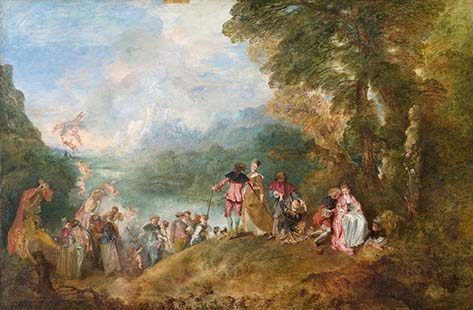
Watteau, Le Pèlerinage à l’île de Cythère, oil on canvas, 129 x 194 cm. Paris, Musée du Louvre.
Over the course of this painting’s long history, it has often been presented as a preliminary version of the Louvre’s Pèleringe à l’isle de Cythère. Certainly the two paintings have much in common. However, it has fewer figures and a less complex composition than the one in the Louvre. In the past and still in current discussions of the painting, it is theorized that this painting is a preliminary study for the Louvre painting. However, their relation is the reverse: this picture is only a reduction of that famous work, measuring one half the size of the Louvre painting, and with additional elements from other sources.
The group of pilgrims in the middle ground repeat the general configuration of those seen in the Louvre painting but without the two pilgrims at the left of the group. They lack the nuanced characterization found in Watteau’s painting. The psychological relationships are not as refined. In the Louvre version the man at the left is meaningfully inclined forward, but not in Le Départ des pèlerins, where he stands stiffly upright and, in effect, repeats the pose of the pilgrim in the immediate foreground.
The couple in the foreground of Le Départ des pèlerins is a variation on the group at the crest of the hill in the Louvre painting. The man assumes a slightly different, awkwardly curved posture; his torso and legs do not have a common axis. His female companion is entirely different. Rather than being based on her counterpart in the Louvre painting, she was derived from a Watteau trois-crayons study now in Bayonne (Rosenberg and Prat 280).
While the painter has retained the broader aspects of Watteau’s drawing, the details are tellingly unsuccessful. Watteau drew her profil perdu with great delicacy, indicating a slight hint of her facial features. In the painting her face is not at all subtle. The lips are positioned too low; the shape of the ear and the depiction of the channeling are awkward. Her coiffure is far too painterly and polychromatic; it lacks the substance of hair and resembles more a bundle of straw.
At the right side of the painting is a statue of a crouching Venus. This work is recognizable as Coysevox’s Vénus accroupie (versions of which are in the Louvre and in the garden at Versailles). In the painting, the sculpture is awkwardly large in relation to the nearby figures and, rather than being crisp, is somewhat flabby. More importantly, Watteau’s painted statues, such as those in Bosquet de Bacchus and Assis au près de toy have a charm and seductiveness that puts them in rivalry with the living humans, but here the statue is shadowed and gray, without personality, much less charm.
The landscape is equally problematic. In the Louvre painting, the mass of trees at the right help enforce the sense of spatial depth, and the graceful branches are characteristic of Watteau’s approach. In Le Départ des pèlerins, the foliage at the right is skimpy and ineffectual. Then there is a sudden jump to distant trees, perhaps misunderstood umbrella pine trees, and they vie for attention with the dull clump of trees at the left side. The spatial relationship between the lefthand and righthand distant trees is confused and ambiguous.
One of the most distinctive features of this painting is the setting sun. A fiery red disk set on the horizon, it finds no parallel with any sky in Watteau’s pictures. Likewise, the rays of light that stream across the sky and over the landscape are striking but find no counterpart in Watteau’s oeuvre. At present the spectacle of the streaming sun rays has been reduced through cleaning and overpainting. Such extravagances are more in keeping with the Romantic visions of Joseph Mallord William Turner. This fiery red sunset was emphasized in the 1776 sale of the d’Arcambal collection: “Un Paysage chaud de couleur, & saisi à l’effet du Soleil couchant.” Indeed, it was a singular effect and were it not for the 1776 description one might have been tempted to think that the sun was a later addition.
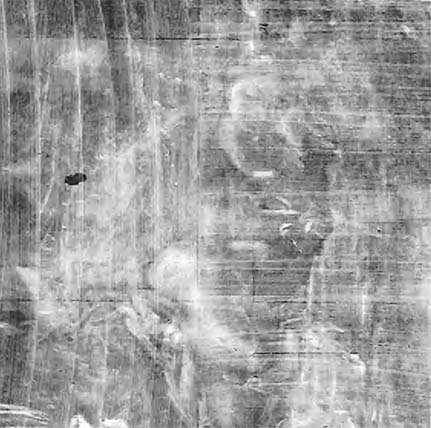
X-ray of Le Départ des pèlerins pour l’Isle de Cythère (turned at a 90-degree angle).
X-rays taken of the painting have been read as showing that when the painting is turned 90 degrees, one can see a preliminary composition of a Rest on the Flight into Egypt underneath. That is less than clear; reading x-rays is often akin to reading a Rorschach test. Moreover, this abandoned composition is claimed to be a preliminary version of Watteau’s Rest on the Flight into Egypt, now in the Hermitage. Such a reading requires a leap of faith. The authorship of this abandoned painting and its relation to the Hermitage painting remain moot.
